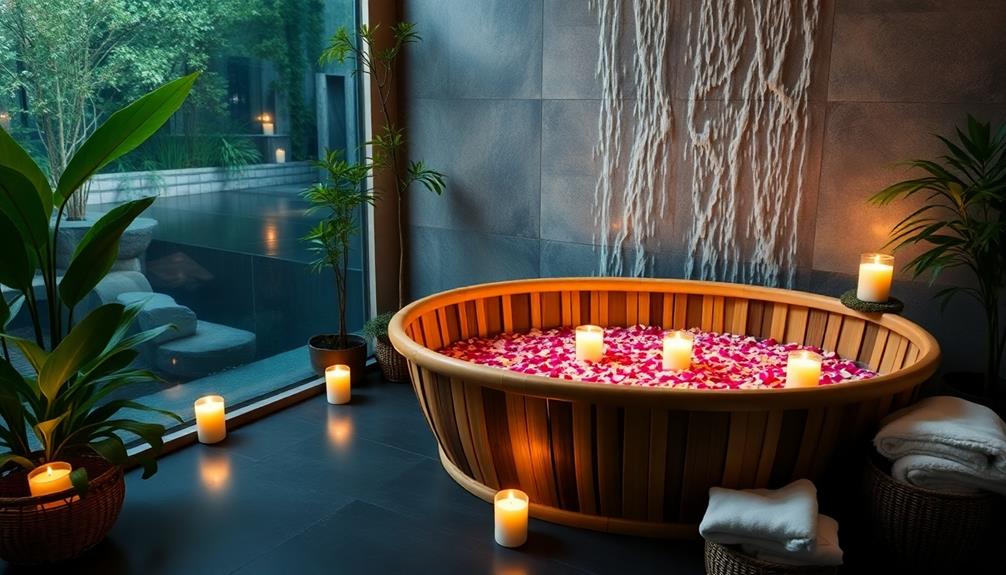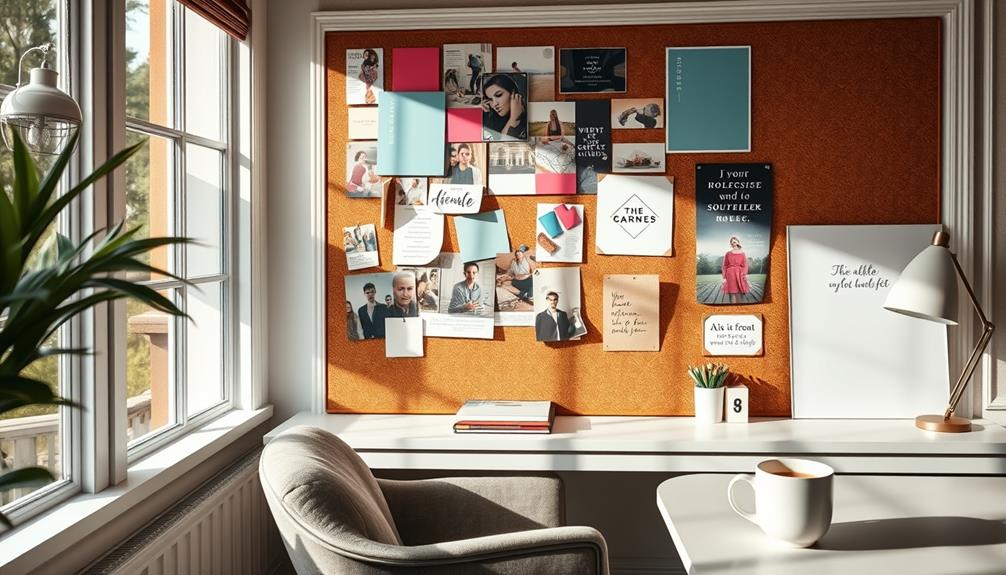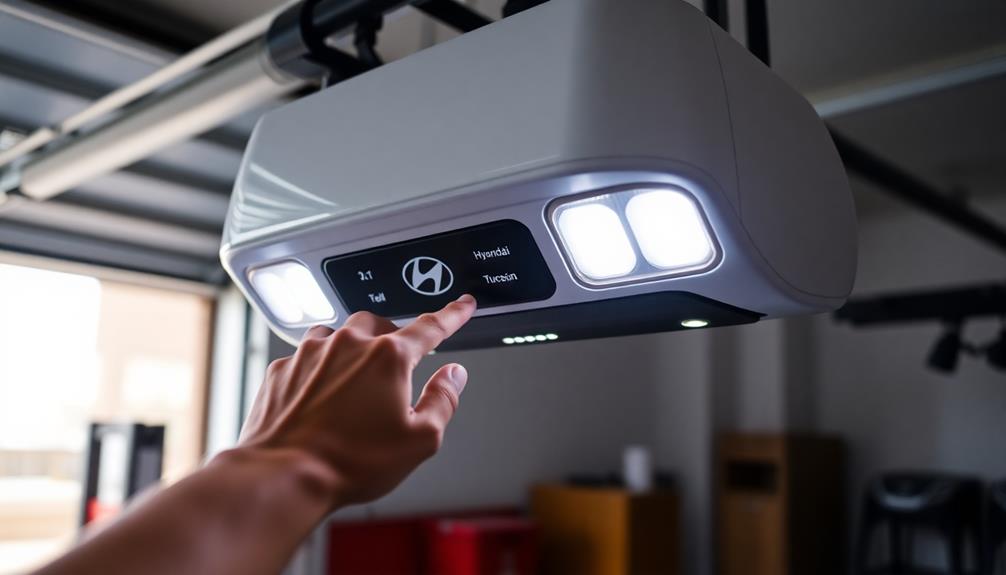You can easily create your dream spa oasis at home by blending calming colors with natural materials. Use light, neutral shades for walls, and integrate wooden or bamboo elements for a soothing effect. Incorporate multi-functional furniture to maximize space, plus mirrors to enhance light. Add essential features like a small whirlpool tub, lush indoor plants, and soft lighting to set the mood. Personalize your space with favorite scents and textiles that reflect your style. With these simple adjustments, you'll transform your space into a relaxing retreat. Stick around for more tips on crafting your perfect sanctuary.
Key Takeaways
- Incorporate multi-functional furniture and vertical storage to maximize space while keeping the area organized and clutter-free.
- Use soft, calming colors and natural materials to create a soothing and inviting atmosphere.
- Add indoor plants and essential oils to enhance relaxation and purify the air in your spa oasis.
- Include comfortable seating and a small whirlpool tub for ultimate relaxation during spa sessions.
- Personalize your space with favorite scents, calming music, and cultural elements that reflect your unique style and preferences.
Space Optimization Techniques
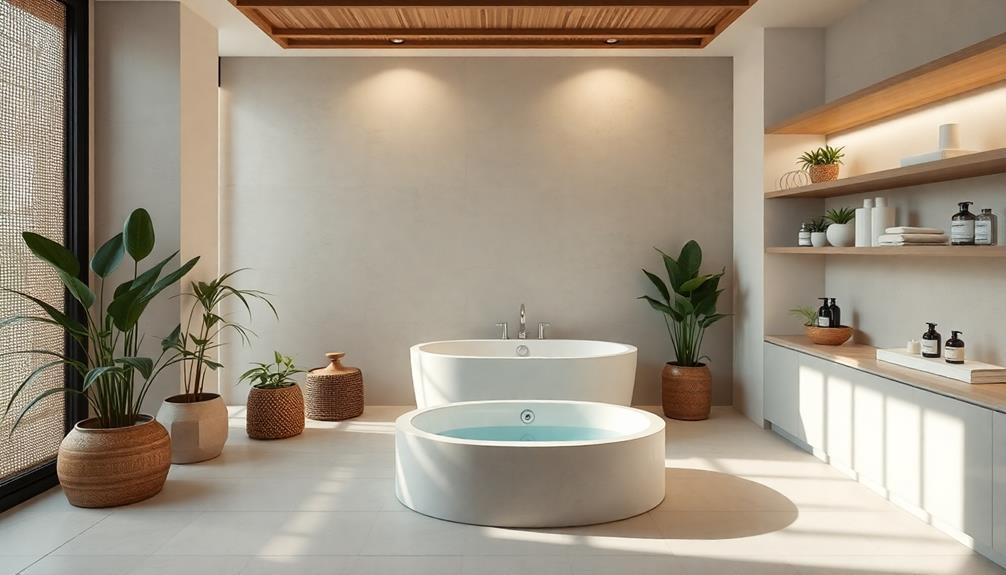
When creating your home spa oasis, effective space optimization techniques can make a significant difference.
Start by incorporating multi-functional furniture like storage ottomans and fold-down tables to maximize efficiency. Using mood boards can help visualize the design elements that will contribute to your tranquil retreat, making certain that you blend beauty with practicality unique charm results.
Use vertical space with floating shelves for your spa essentials, keeping everything organized and accessible. Opt for light, neutral colors on walls and furniture to enhance openness and create an airy feel.
Strategically placing mirrors can reflect light and give an illusion of a larger space. Focus on decluttering to maintain a serene environment.
Finally, consider space-saving features like compact whirlpool tubs or mini waterfalls to guarantee you have all the luxuries of a spa without overwhelming your area.
These strategies will help you create a tranquil retreat.
Creating a Calming Atmosphere
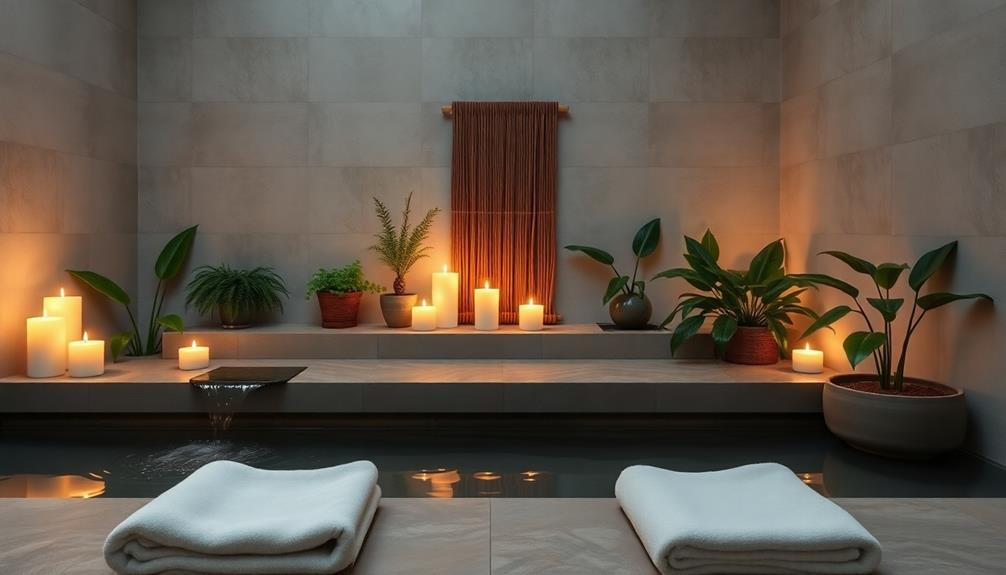
To create a calming atmosphere in your home spa oasis, focus on incorporating soothing colors and natural materials that promote relaxation. Soft blues, greens, and earthy neutrals work wonders. Add wooden accents and indoor plants to enhance the tranquil vibe. Opt for dimmable lighting to adjust the mood, and use scented candles or essential oils to engage your senses.
| Element | Description | Benefits |
|---|---|---|
| Calming Colors | Soft blues, greens, neutrals | Promotes relaxation |
| Natural Materials | Wood, bamboo | Creates a soothing effect |
| Indoor Plants | Ferns, peace lilies | Purifies air, boosts mood |
| Warm Lighting | Dimmable fixtures | Sets a cozy ambiance |
Essential Spa Features
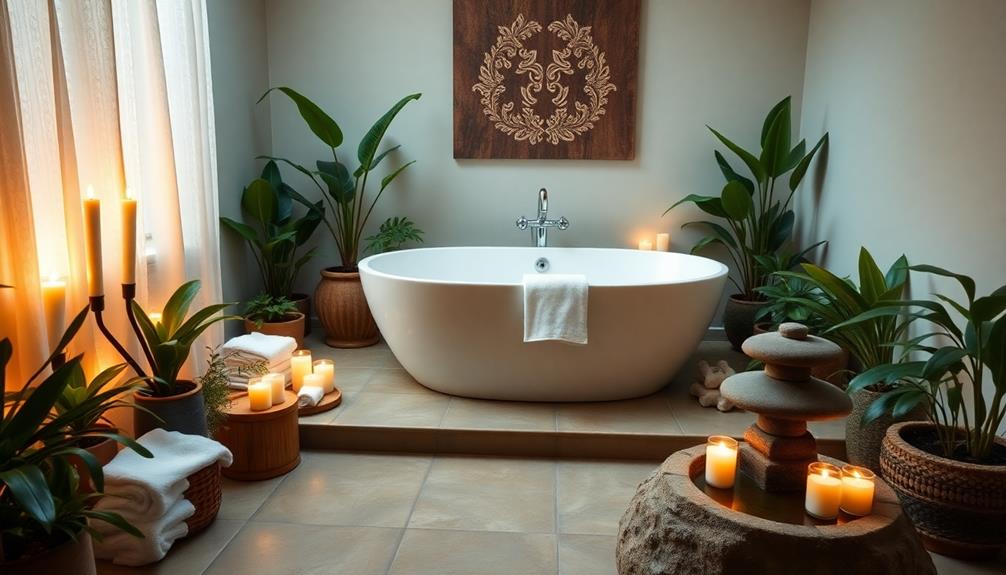
Creating your home spa oasis involves incorporating essential features that enhance relaxation and rejuvenation.
Start with comfortable seating, like plush chairs or a cozy chaise lounge, where you can unwind. A small whirlpool tub can elevate your experience, providing soothing warmth.
Incorporate natural elements, such as indoor plants or a decorative fountain, to promote tranquility. To enhance the soothing atmosphere, consider using essential oils, such as essential oils for respiratory health, that can help clear your mind and open your airways.
Dim lighting and candles create a serene ambiance, while calming scents from essential oils or incense help you relax further.
Add soft textiles, like plush towels and a warm blanket, to elevate comfort.
Personalizing Your Spa Experience
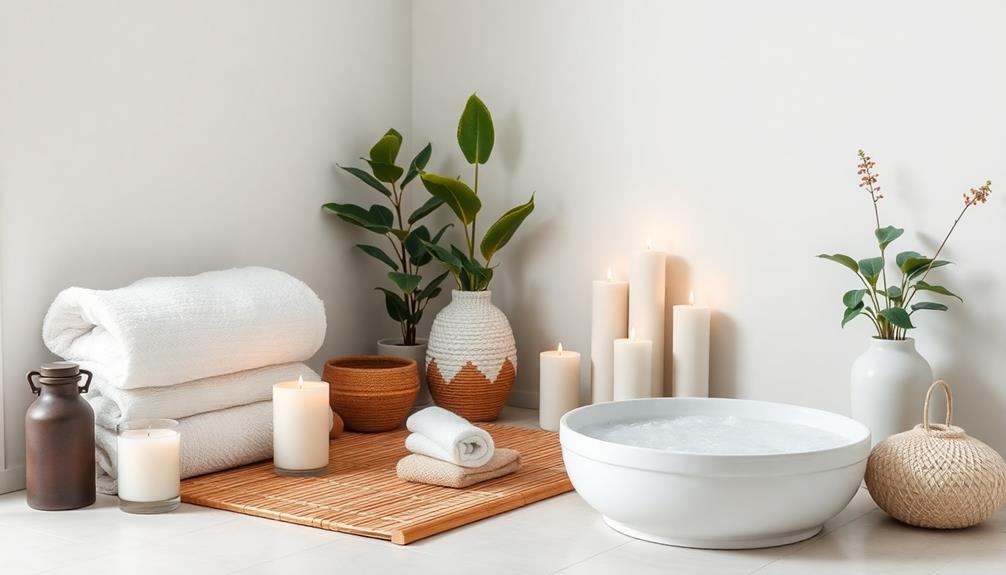
Personalization transforms your spa experience into a sanctuary tailored just for you. By incorporating your preferences, you can create an oasis that truly reflects your style and needs.
Consider these key elements to enhance your spa experience:
- Choose Your Scents: Use essential oils or candles that evoke feelings of tranquility. Incorporating scents that resonate with your mood can deepen relaxation and enhance emotional well-being, similar to the benefits of music therapy integration.
- Select Music: Curate a playlist of calming tunes or nature sounds that help you relax.
- Personal Touches: Add favorite books, magazines, or photos that bring you joy.
- Comfortable Textiles: Invest in plush towels, robes, and cushions to elevate your comfort.
With these personal touches, you'll find your at-home spa becomes a unique retreat where you can unwind and rejuvenate in style. By adding luxurious bath oils, plush towels, and calming essential oils, you can transform your living space into a haven for relaxation. Whether you prefer a hot bubble bath, soothing meditation, or a rejuvenating facial, your at-home spa can cater to all your self-care needs. With the right ambiance and amenities, you can create a serene environment that promotes inner peace and tranquility.
Incorporating Cultural Elements
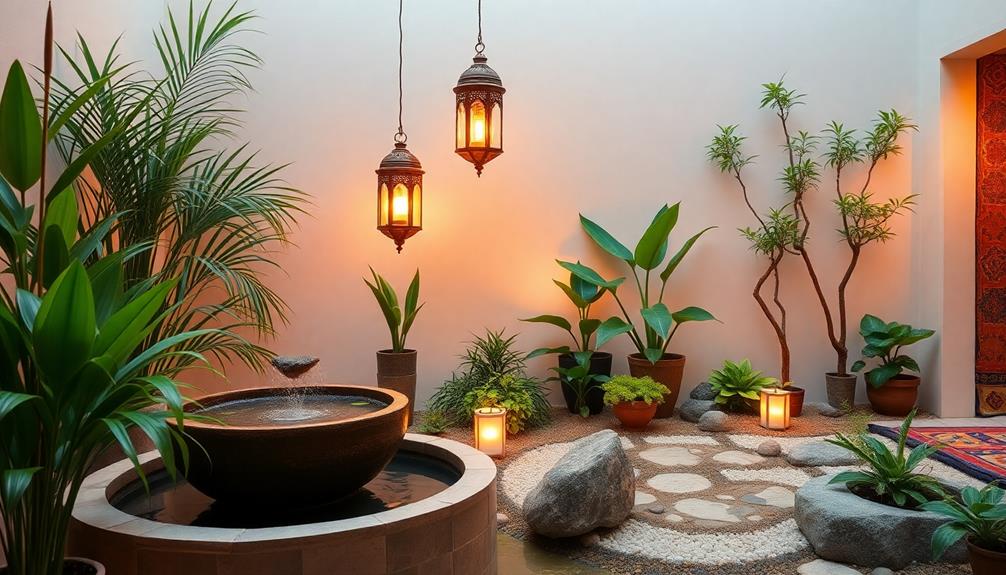
Incorporating cultural elements can transform your home spa into a vibrant oasis that reflects your heritage or the cultures you admire. Think about adding textiles, art, and scents that speak to your roots or evoke the tranquility of places you've visited.
Here's a quick guide to inspire your choices:
| Element | Cultural Influence | Idea |
|---|---|---|
| Textiles | Moroccan | Use colorful rugs or cushions |
| Art | Japanese | Hang bamboo wall art |
| Scents | Indian | Incorporate sandalwood incense |
Maintenance and Sustainability Tips
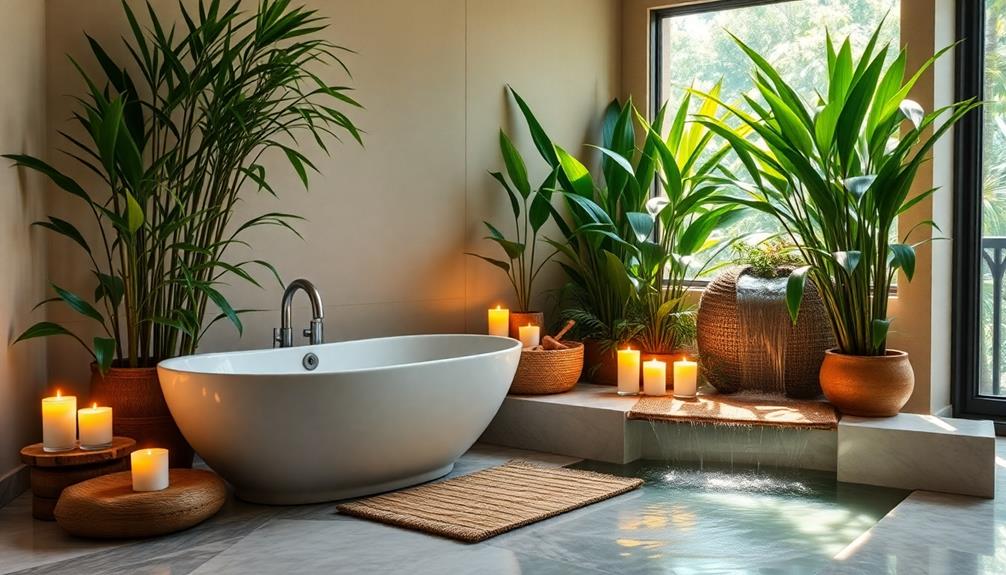
Keeping your home spa in top shape requires attention to maintenance and sustainable practices. By implementing these tips, you can enjoy your oasis while being eco-friendly:
- Regular water care: Test and balance water chemistry weekly to guarantee cleanliness and longevity.
- Eco-friendly materials: Use sustainable products for spa decor and accessories to reduce your environmental footprint.
- Energy-efficient systems: Invest in energy-saving appliances and lighting to minimize energy consumption.
- Water conservation: Implement measures like water-saving fixtures and mindful usage to conserve water resources.
Practical Spa Design Ideas
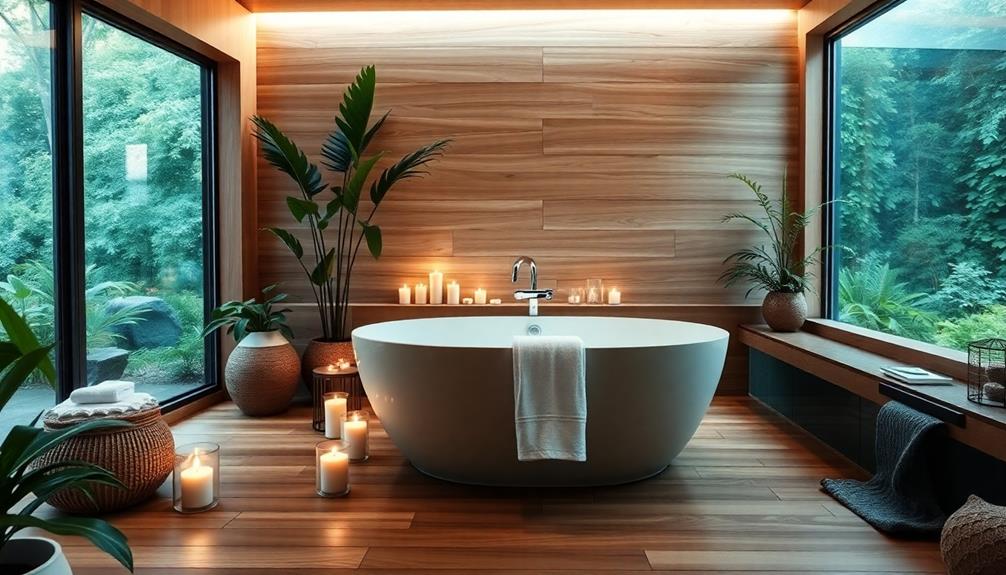
Maintaining a sustainable home spa sets the foundation for creating a serene retreat, but thoughtful design can further enhance your experience. Start by optimizing your space with multi-functional furniture and vertical storage solutions. Choose light, neutral colors to create an airy ambiance, and add mirrors to reflect light and expand your area visually. Incorporate calm colors and natural materials for a soothing effect, and don't forget indoor plants for rejuvenation. When it comes to home spa ideas, consider adding a luxurious bathtub or a steam shower for a truly indulgent experience. Invest in high-quality, plush towels and robes, and incorporate aromatherapy with essential oil diffusers or scented candles to elevate your relaxation. Personalize the space with calming artwork or inspirational quotes to create a tranquil environment for ultimate relaxation.
| Design Element | Description |
|---|---|
| Multi-functional Furniture | Use storage ottomans and fold-down tables. |
| Vertical Storage | Install floating shelves and wall units. |
| Calming Colors | Opt for soft blues, greens, and neutrals. |
| Natural Materials | Incorporate wood and bamboo elements. |
| Indoor Plants | Add greenery for air purification. |
Frequently Asked Questions
How Much Space Do I Need for a Home Spa?
You'll need at least 100 to 200 square feet for a home spa, depending on your desired features. Consider space for essentials like a tub, seating, and storage while ensuring a calming, uncluttered environment.
What Is the Average Cost of Building a Home Spa?
You might think building a home spa's too costly, but average expenses range from $5,000 to $30,000, depending on features. Prioritize what you value most, and you'll create a personal retreat tailored to you.
Can I Install a Spa Outdoors?
Yes, you can install a spa outdoors. Consider your space, guarantee proper drainage, and check local regulations. With the right setup, you'll create a relaxing retreat right in your backyard. Enjoy the tranquility!
What Materials Are Best for Spa Construction?
When choosing materials for spa construction, balance durability and aesthetics. Consider natural stone for elegance and wood for warmth. Don't forget eco-friendly options; they promote sustainability while enhancing your spa's tranquil atmosphere and overall appeal.
How Can I Enhance Privacy in My Home Spa?
To enhance privacy in your home spa, consider installing privacy screens, using landscaping for natural barriers, and adding soundproofing materials. Soft curtains or frosted glass can also create a serene, secluded atmosphere you'll love.
Conclusion
By creating your dream spa oasis at home, you're not just enhancing your space; you're investing in your well-being. Studies show that spending just 20 minutes in a calming environment can greatly reduce stress levels, boosting your mood and overall health. So, embrace those soothing colors, lush plants, and personalized touches. Your sanctuary awaits, ready to rejuvenate your mind and body. Immerse yourself in this journey of self-care, and watch how it transforms your daily routine.
